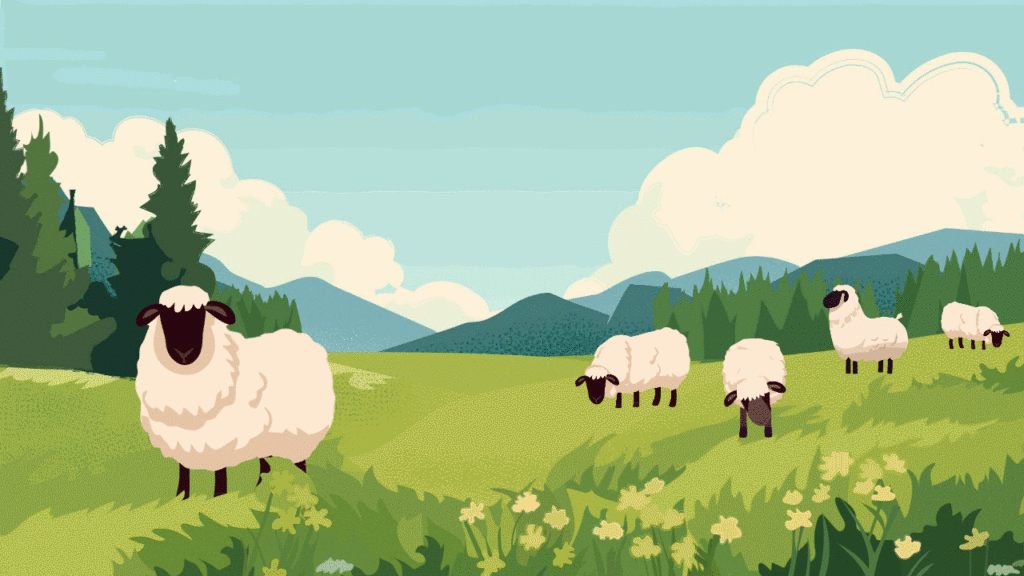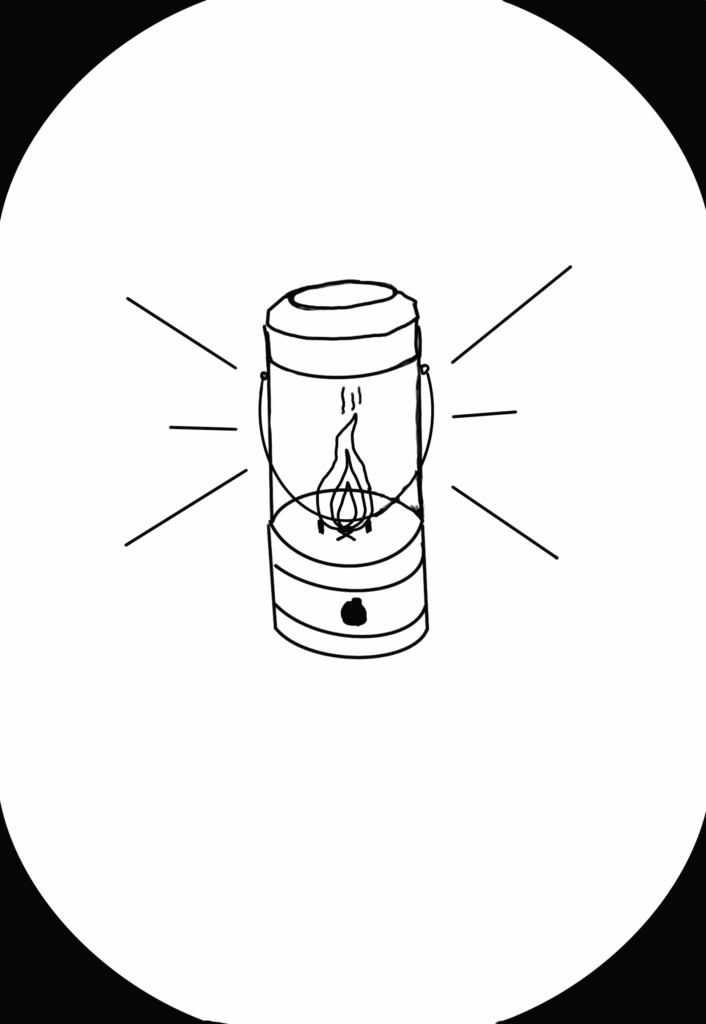Experiments 1-4
Question sets 1-3
Animation Experiment 2

This is my second rendition of animating my sheep. I added more sheep, texturized the elements, and added movement to the flowers. My export settings washed out the color on the flowers, unfortunately. For my next version, I’ll have to fix that, add a shepherd, and smooth out the movements. What do you think? Any suggestions?
5 Game Ideas On Campus
- CA Scavenger Hunt: This game takes place across the freshman dorms, with each residence hall competing as a team. The objective is: be the first dorm to take a selfie with every CA from the freshman buildings. By working together, residents not only bond with their teammates but also get to know their CAs and connect with other students across campus. There could also be a prize involved for the building that wins.
- Cafe Race: In this tame based game, players start outside Nicholson and race to build the best meal possible. Each food item has a point value based on effort and wait time. For example, a custom sandwich from the deli line is worth more points than a quick slice of pizza. The challenge is balancing speed with strategy: players must decide whether to grab fast, low-value items or risk waiting longer for higher-value choices. The winner is the player who assembles the highest-scoring meal in the shortest amount of time.
- Capture the Coffee Cup: This campus twist on Capture the Flag replaces the flag with a coffee cup. Two teams are against each other, both representing a campus coffee shop: Saxby’s or Romo’s/Starbucks. The objective is to infiltrate the opposing team’s territory, steal their coffee cup, and bring it back safely to your side. Just like the classic game, teamwork, strategy, and speed are key to victory.
- Romo Hunt: Inspired by Pokémon Go, this mobile game would send students across campus in search of digital Romos. Using a campus specific app, players walk around to discover and collect Romos that appear at different locations. The more Romos a student finds, the more points they earn. To keep the game dynamic, Romos would respawn and move every few minutes or hours, encouraging students to stay active and explore new areas of campus.
- Foot-Volley: Played on the campus sand volleyball courts, this game combines soccer with volleyball. Students form small teams of 4–5 players to keep the game fast and engaging. Players aren’t allowed to use their hands or arms. Instead, they must rely on their feet, legs, chest, and head to pass, set, and spike the ball over the net.
(9/4/2025 Meredith_B) Reading/Homework Questions
Question Set 1
- What Mechanics would you like to use for a game with a theme that revolves around being the size of a nanometer?
- I think having a jumping or shrinking system would be cool. Jumping in context of jumping over/around household objects, or shrinking to open the opportunities to have a tall and tiny version of the game (Like Antman)
- Who are you making games for?
- I want to make fun for ages 12+ as that is a good range to have some somewhat complex mechanics, but also to keep the game easy to understand, allowing for my game to reach wider audiences and be a generally family friendly game.
- Who will be your play testers outside of class?
- Mostly friends/peers, since I am too far away from home to test board games on younger family
Question Set 2
- Can you think of a game you were able to play without referring to the rules?
- Uno,Life,Cards Against Humanity, Blackjack
- How do you define what a game is?
- A game is something that has a set of rules to push players into a state of mind for some kind of goal to be completed in some way.
- What features can make your games more intuitive?
- Keep point values/ important information is placed on cards or game pieces so they are always visible and can be easily referenced.
Question Set 3
- What was your gateway game? What do you play to introduce others to gaming?
- It depends on if its for tabletop or video games. For tabletop games my gateway game was Candyland, and Minecraft was for videogames. To introduce people to games, I would offer them UNO and MInecraft or Roblox, since they are easy to understand and can be adjusted and there are multiple versions and ways to branch out, and starts a good foundation for other games.
- What features do gateway games share?
- Easy to pick up, simple concept and rules, and can be understood by 99% of the population.
- What are the 10 beautiful mechanics and what should you aim for with your own?
- Kingmaker’s Noblesse Oblige, BattleTech’s Heat, Set’s Set-making, Magic Card Tapping, Battle Cattle Cow tipping rule, xXxenophile’s Popping, Bohnanaza’s hand order rule, Mississippi Queen Paddlewheels, Times Up Communication breakdown, Dominions constant shuffling. As a gamemaker, you should aim to understand and use these guidelines as a bar to go above in order to make your game successful.
- How does luck and strategy factor in to game play?
- It adds a factor that the game can always keep changing until the final moment and keeps the player engaged. It’s no fun when one person is always winning, so luck can help anyone win, and strategy can be used to push the factors of luck more to help someone win.
Homework:
- Game similar to uno, but its collecting cards instead of getting rid of them
- Card game version of battleship?
- Dress up based card game, score points based on outfits
- Zombie apocalypse card game, have to pick teams
- Interior decorator card game, based on locations of decor gives points
(9/4/2025_MeredithB) Playtest: Bohnanza
- Was it fun?
- I didn’t really enjoy the game, it was a weird premise and the game itself was difficult to understand. We had to watch a video to understand it (I still did not understand it) instead of reading the rules, and overall I did not enjoy the game. It didn’t really have a major goal other than collecting coins, which was a very passive goal, and that was it.
- What were the player interactions?
- There was, so in the game you either have to trade or donate cards if you don’t want them. This caused a lot of arguing and negation to be made in order to get the cards we wanted, but also to give away cards so we don’t have to deal with them.
- How long did it take to learn?
- 1hr+, at least for me. I was still trying to understand and learn the game for the entire time, in comparison my peers understood it quicker, but it would have been closer to 20-30 minutes for them.
- What was the most frustrating moment or aspect of what you just played?
- Just trying to understand what a “turn” is within the game and how to properly play. It changed how many things could be planted and played depending on trades, and overall I could never tell if I accidentally played too much, or I was essentially skipping my turn.
- What was your favorite moment or aspect of what you just played?
- The premise and conceptual idea of the game was cool, but I just didn’t like any of it. The playstyle, the rules, and even the look of the cards weren’t for me, but I can understand how this game would be desirable for others.
- Was there anything you wanted to do that you couldn’t?
- Buy more plots of land, you were only allowed to have 3 plots, I wish you could have 4 or even 5 instead. However I understand why players are not allowed to do this, as it would take away from the sacrifice that can be made based on trades.
- If you had a magic wand to wave, and you could change, add, or remove anything from the experience, what would it be?
- The artwork was not for me, and in general I would change the whole game so it isn’t Bohnanza. The game just isn’t for me like I have stated, so I would change the whole aspect of the game.
- Is this a game you would play again? Yes _____ No ______ Why
- Nope, I didn’t enjoy the game or the concept of the game, so I would not go out of my way to play it.
- Analyze the game using the 3 act structure.
- (Act 1: Start) The start was setting up plots, learning the rules and getting your starting hands. This section was the quickest since it was just distribution of cards and taking things out of the box. (Act 2: Middle) This was the longest section, lasting over an hour, and would have been longer if we would have followed the rules and went through the deck 3 times. This section, due to the nature of the game, was designed to be the longest. (Act 3: End) Although this section would have been longer if we played longer, it only took a few minutes since the only point system is whoever has the most coins in the end.
5 game ideas that can be played using cards
- Similar to SushiGo, there would be a card game about books where you have to match the name of the book to the blurred-out photo of the cover, which you can then stack with the name of the author for more points. And the more of the series of books that the author has that you get within your set, the more points you have.
- Another card game idea I had was that every player has a theme and some cards, there are Lego pieces you can mix and match, but each player must pull blindly out of the stack of cards as the person goes around and randomly selects a card, and at the end of the turn everyone has to find their designated Lego pieces and build something along the lines Of the theme and each player has to go around and put in their guess as to what the person built and the more people that guess correctly the more points that player collects.
- Again, taking the idea of picking up and putting down cards each round like SushiGo with a deck of cards, each player gets 13 cards, and you have to go around and put one card down each turn, then swap decks, but the goal is to get every card in order from greatest to least, the fastest. Whoever has Ace through 10 and double points for face cards gets the most points, and triple points for the same color and suit the whole way through.
- Blackjack, but 2 die decide what number you’re trying to reach, the number that comes out of the die roll, instead of hitting 21.
- Tabboo, the card game, but your team must play deaf ( they all have headphones on with music), and only the other team can listen in.
(9/4/2025_Meredith B) Playtest: Sushi GO!
- Was it fun?
- Pretty enjoyable, it was simple and easy to understand, plus it was more of a luck based game rather than 100% skill, so the randomness made it fun.
- What were the player interactions?
- Yep, it was at 1st confusion but it was more or less just the counting of cards, since the game is so luck based.
- How long did it take to learn?
- About 5ish minutes, it was quicker than expected. The hardest part to learn was that stacking and point mechanic, but the cards showed you what to do so it worked out.
- What was the most frustrating moment or aspect of what you just played?
- Nothing was honestly frosting, except for the chopsticks card, cause if you have one left it’s worth nothing, so on the last hand there is a chance you don’t get any extra points.
- What was your favorite moment or aspect of what you just played?
- It was very cute, the premise was simple to follow and the artwork was very cute, which made it aesthetically pleasing to play.
- Was there anything you wanted to do that you couldn’t?
- Not really, except I wanted the wasabi card to be worth more then x3 or nothing.
- If you had a magic wand to wave, and you could change, add, or remove anything from the experience, what would it be?
- Add a point value towards the chopstick and wasabi cards, just so they don’t become useless cards.
- Is this a game you would play again? Yes _____ No ______ Why
- I would, it is a very easy game to pick up and play for a little, without dedicating hours towards learning a game. Almost anyone (except for kids under 5) can play and enjoy the game, so it makes Sushi Go! A very family friendly game, hence allowing it to be brought to more events and shared, which makes me more likely to play it.
- Analyze the game using the 3 act structure.
- (Act 1: Start) This section was learning the rules/ point scoring for the game. It took maybe 5 minutes to learn the premise of the game, however we kept referencing the rules for the 1st few rounds until we 100% understood the rules. This section also included dealing the cards, so overall the start was the shortest section, maybe 30 seconds of play) (Act 2: Middle) Main part of the game, this is where we would actually play the game. This part was fun since it was the actual game where we were passing around cards and playing. (Act 3: Ending) This is where we would count points and totals. It went fairly smoothly as the point system was easy to understand, plus the cards had the values written on them. The longest part of this section was tallying up final points and comparing/adding them to previous rounds to determine a winner.
5 Games that can be played using cards – Mathews
- I had an idea for a game that blended the rules of blackjack and spoons. Players take turns collecting and passing cards in order to get a hand of cards with a value equal to 21. Players must pass cards that they do not need to another player until a player reaches 21. When a player does reach 21, they can hit the table and remain safe. The last player to hit the table loses.
- I thought of a card-based game where players are given a random card from a standard deck, and tasked with sorting themselves in numerical order. Players can not state their number, or show their card, and must find unique ways of communicating their position in the order. Points are distributed to the players that can correctly identify their position.
- I had an idea for a card game called “Market Rush” where players own grocery stalls and draw cards with items to generate income. Each round is separated by two periods, the “open” time and the “buying” time. During the “open” time, players draw status or chance cards from a deck that influence the current or next day. After the markets close, players can draw cards from a separate deck to redesign their strategy. A player can draw a “lettuce” card, which generates 2 “coins” per day, but overnight a player can draw a “drought” card which halves the revenue of all crops. This would require players to evaluate their strategy.
- I’d like to make a card game that requires players to know a bit of information to make interesting plays. In my game “”, your goal is to unlock all locked elements and molecules using real chemistry methods. You start with a couple of element cards, some molecule cards, and some “machine” cards. Using this start, you can begin the puzzle of unlocking all elements. For example, a player can start with 1 “Water Molecule” card, “Yttrium Element” card, “Electrolyte Machine” card, and a “Chemical Reactor Machine Card”. A player can research the materials and learn that electrolytic water allows you to collect oxygen, which can be reacted with Yttrium to make Yttrium-oxide.
- I have an idea for a game called “Wager”, where players need to bluff their way to victory. Players have chips, which represent value that they must wager to make the plays needed to get rid of the cards that they need. The first to get down to 0 cards will win the game, but you lose if you run out of money.
Munchkin Play test Review – Bryce Mathews
I believe that Munchkin is a fun game if all the pieces fall into place. It is a nice take on the turn-based card-drawing model. Unlike a game like FLUX, Munchkin encourages you to act out of turn, make informal deals, and make strategies on the flyby helping or hindering others.
There were many great interactions our group had while playing. After we overcame the learning curve, we opted to help each other if needed and build strength individually. This came crashing down when one person decided to curse another, which started pitting players against each other.
We were learning all of the time while playing. There were so many intricate conditions and terms to understand to play the game the way it was intended, which was a bit overwhelming. We had to take a while to understand how each turn worked.
The most frustrating moment was being targeted because I was getting close to winning.
My favorite part of playing was winning because I negotiated a deal to help fight a monster.
I wanted to carry more cards I believe that the hand limit, while nice in encouraging players to sell and donate, really hurt our ability to strategize for the long term.
I would tweak the rule book and simplify certain systems. It was quite the read.
I would play Munchkin again. While it is difficult to understand when starting, the liberties that Munchkin allows you to take makes the game much more dynamic.
While there was no set story in Munchkin, there was definitely an early-game, mid-game, and end-game. In the early-game, every player did not work together much, and it took a while to understand the mechanics. In the mid-game, there were more interactions between players, like team-ups and trades, with the inevitable betrayal. The end-game became a close race to the level 10, with players throwing anything they could to make another player lose their fight.
Sushi Go! Analysis
Was it fun? Meh
What were the player interactions?
There wasn’t much player interaction, the only interaction was the passing of the card hands. Besides that you could affect other players but yourself, so there wasn’t much competitiveness or excitement.
How long did it take to learn?
Not too long, we only were confused about the different sushi combinations, but once we were familiar enough it was easy to play.
What was the most frustrating moment or aspect of what you just played?
I honestly wasn’t frustrated at all but if I had to choose something it would be only being able to play one card at a time besides using the chopshick cards. This game was simple enough where it is hard to choose something to be frustrated about.
What was your favorite moment or aspect of what you just played?
My favorite aspect was the point system and the visuals of the game. I like games where you have to get the highest score and keep track of points over time. As for visuals the cards and sushi characters were adorable and colorful, it was very appealing to look at.
Was there anything you wanted to do that you couldn’t?
Not really, but again I would want to play more than one card when I couldn’t.
If you had a magic wand to wave, and you could change, add, or remove anything
from the experience, what would it be?
I don’t know exactly what could be added without changing the whole game, but if I had a magic wand I would add better player interaction or card stealing aspects. I would do this to add some competitiveness between the players besides only the points being used as the competitive aspect.
Is this a game you would play again? Yes _____ No ______ Why
I probably would play again, but it wouldn’t be my first choice because I have a very competitive personality and this game wasn’t very competitive, but I enjoyed the simplicity of it.
Analyze the game using the 3 act structure.
Setup: The set up of the game starts with a specific amount of cards each player has, and getting a feel for what combos and cards to first put down to start the game. There are no set characters, but the sushi characters are the points so the players begin to think of their next moves. The setup creates the foundation as players begin to think of what they might collect and how others might play.
Confrontation / Rising Action: The rising action of the game is when players draft and pass cards, balancing point gains with strategy. Collecting sushi sets, timing pudding (dessert) cards to prepare themselves for the end of the game. The rising action is driven by both opportunity and risk with every hand when the players are still creating their meals strategically.
Resolution / Climax: At the end of the final round, all points are tallied (including the dessert cards that can swing the outcome). The climax arrives when it’s revealed who built the “best sushi meal” (highest score). This resolution provides closure, with all earlier decisions leading to who used their hands wisely, who took risks, and who ultimately won.
Munchkin Gloom Analysis
Was it fun? Yes!
What were the player interactions? Player interactions were similar to fluxx where you can affect other players hands, characters, and plays. It gives a sense of competitiveness because you start to target people by stopping their characters from becoming gloomy and dying, or taking people’s cards (of course when there is an action card that says so). So overall there is a lot of player interaction in Munchkin Gloom.
How long did it take to learn? It took a whole “dummy hand” for us to learn, but during the second game we played it was a lot more enjoyable and it ran smoothly.
What was the most frustrating moment or aspect of what you just played? The most frustrating part was figuring out what cards were. We struggled with this because they all look very similar, and at first without knowing or getting familiar with the cards we had to examine them extra hard to figure out what could be done with specific cards.
What was your favorite moment or aspect of what you just played? My favorite aspects of the game were the visuals of the game and the self-worth/ point system. It was easy to keep track of the self-worth points and other symbols because the cards were clear, and I also enjoyed the medieval look of the characters and cards in general. As for the self-worth aspect of the game, it brought competitiveness out of everyone and forced us to change each other’s cards/ target each other. I also just thought it was a creative take on the game.
Was there anything you wanted to do that you couldn’t? The only thing I wanted to do that I couldn’t was use my untimely death cards whenever I wanted rather than using it as your first play. We all kept forgetting that rule, but I do see the purpose of it so the players can’t give their own negative points and then untimely death all in one move. Without that rule the game wouldn’t be as interesting or long.
If you had a magic wand to wave, and you could change, add, or remove anything
from the experience, what would it be? The only thing I would change would be the look of the cards. It was easy to take other players’ untimely death/ event cards because the other cards looked different. I felt this was annoying because of course other players would pick those cards over others.
Is this a game you would play again? Yes _____ No ______ Why
Yes, because ultimately I enjoyed the second round of playing and it was fun targeting other players and it became competitive, which I enjoy because I am a very competitive person. Also, I thought it was a funny take on the game with being the most miserable person, having the most miserable characters, and then killing off all your players. I think it’s unique because it’s the opposite of the majority of games.
Analyze the game using the 3 act structure.
Setup: This is when players establish their foundation and everyone chooses their party members and characters, learn their backstories, and receive the dealt cards. It introduces the world, the characters’ identities, and sets the tone for the game. The stakes and goals start to take shape here.
Confrontation / Rising Action:The main gameplay happens here. Players begin to manipulate the narrative by assigning negative self-worth to their own characters and positive self-worth to other players’ characters. Action cards and early “untimely death” plays introduce conflict, alliances, and rivalries. This is where strategy, tension, and drama build.
Resolution / Climax: The endgame arrives when only a few characters remain alive. This act is about timing and execution and choosing the right moment to play untimely death cards. The suspense increases as players attempt to plan their story outcomes, and the game resolves with final self-worth points and the narrative payoff of whose team is all dead first.
Game Questions Week 2
Bohnanza Madison Hurst
Was it fun? I thought this game was pretty fun at points. Though in some areas of the Bohnanza it was slow because you were waiting a long period of time for your turn. I did enjoy how it forced you to think about what cards you had to keep by adding limitations or getting rid of specific cards before you can use your own hand.
This game was highly interactive, with players decisions directly affecting others. Trading cards often led to tough choices, especially when multiple players wanted the same card. Players competed to collect and harvest specific cards to get coins.
How long did it take to learn? The game didn’t take long to learn because it would end after we went through the deck of cards three times. So, we had plenty of time to understand and fully play. I would say it took about 15 minutes to fully comprehend and begin playing competitively. The only confusing part in the beginning was understanding how you gained points/coins.
What was the most frustrating moment or aspect of what you just played? The most frustrating part of the game was not being able to “steal” cards from your opponents after they planted the bean. For instance, Meredith and I had the same bean planted, and we couldn’t steal from each other after the bean was planted or placed down.
What was your favorite moment or aspect of what you just played?- My favorite moment of Bohnanza was collecting the coins. It was fun being able to take 2-3 coins after gathering multiple cards of the same bean.
Was there anything you wanted to do that you couldn’t?- After you were done with a card or didn’t have a use for it at that point in the game, you would discard it. But I really wanted to bring back that card later on in the game because it would’ve been beneficial. So, I just wish the discard pile was recycled faster.
If you had a magic wand to wave, and you could change, add, or remove anything
from the experience, what would it be? I would probably change the pace of the game and just go through two decks of cards instead of three.
Yes, I’d play again because I enjoyed the challenge of making the most of my cards and the engaging trading aspect of the game. This kept the game interesting despite occasional slow turns.
Analyze the game using the 3 act structure.
The act of the game is when players start to learn what each card type is worth, and exploring the rhythm of planting the beans. At this point, trading cards are hearted, and players can be unaware of the meaning or unable to see the full effect of that trade. The second act is when the players are in the middle of the game. This is when competition kicks in and trading deals go wrong, or someone is on the wrong end of the deal. Moreover, we see players start to get a vast collection of cards, and are thinking about harvesting and collecting their coins. The third act is when the game is close to being complete, and every bean planted matters. Trades are extremely cutthroat or can lead a player to victory. The resolution happens in this act, and this is when all the coins are accounted for, and we see who the victor is.
Kobold Guide to Game Design: Part 2 Questions
Question Set 1
- What Mechanics would you like to use for a game with a theme that revolves around being the size of a nanometer?
- Some Mechanics I would use for a game with a theme that revolves around being the size of a nanometer would be themes like dynamic movement and environmental gradients, with the main focus being color and clear symbols on the game pieces and board. This functionality would enable the user to intuitively interact with the game’s function and meaning, which correlates with the environmental factors. The elements and themes were taken by Werner Hodel’s Mississippi Queen, where “speed” is the key to energy and movement, as well as the idea of a changing environment, which alludes to the idea that “luck” has a component in the game.
- Who are you making games for?
- I am making games for the newcomers and myself. Games that are designed as the “whole package” where the sole purpose is to provide entertainment and an escape from their lives. It also provides social interaction, giving the audience a reason to play.
- Who will be your play testers outside of class?
- My playtesters outside of the class will be friends, family, my significant other, gamers, and non-gamers.
Question Set 2
- Can you think of a game you were able to play without referring to the rules?
- A game I was able to play without referring to the rules had to have been Uno, just because of how well-known it is, but also, I feel like it could also be one of those Gateway Games where somebody always knows how to play, and once you learn it, you never forget it.
- How do you define what a game is?
- As James Ernest defines it, “A game is a way to play by a set of rules”. But not only does he say that, he goes on to explain that it’s the package as a whole, not just the rules. The whole package is the theme, mechanics, a brand, a hook, and a lifestyle. As well as mentioned previously, something that draws attention with a reason to play and escape.
- “A game is an interactive mathematical system, made concrete, used to tell a story.”
- As James Ernest defines it, “A game is a way to play by a set of rules”. But not only does he say that, he goes on to explain that it’s the package as a whole, not just the rules. The whole package is the theme, mechanics, a brand, a hook, and a lifestyle. As well as mentioned previously, something that draws attention with a reason to play and escape.
- What features can make your games more intuitive?
- From the reading, what I gathered was that the biggest thing you can do to make a game more intuitive is to have the physical components and graphics that the game should be able to be played and directed simply by the pieces. Keeping colors consistent can avoid confusion, as well as how form follows function, and how size can come into play, especially with a clear game layout. The components should be a reminder of the rules how each piece looks and feels should explain or give narrative to the rules.
Question Set 3
- What was your gateway game? What do you play to introduce others to gaming?
- Uno was my Gateway game, but honestly, I think now SushiGo might be my new Gateway game. I honestly want to start making people play SushiGo, obviously that, and Uno, to introduce gaming to other people.
- What features do gateway games share?
- Some features that the Gateway game shares are the idea of playing by luck, as well as ease of learning, interactivity, and duration.
- What are the 10 beautiful mechanics and what should you aim for with your own?
- Kingmaker’s Noblesse Oblige, BattleTech’s Heat, Set’s Set-Making, Magic’s Card Tapping, Battle Cattle’s Cow Tipping Rule, xXxenophile’s Popping, Bohnanza’s Hand Order Rule, Mississippi Queen’s Paddlewheels, Time’s Up!’s Communication Breakdown, and Dominion’s Constant Shuffling
- I should aim for forcing hard choices as well as simplicity, intuitively, engaging, purpose/theme, iteration, and replayability for my own game.
- How does luck and strategy factor in to game play?
- Luck factors into games like Gateway Games, which can introduce non-gamers to games as well as leveling the playing field, making everyone feel included and have a chance to win, which again leads to small victories.
- Strategy factors into gameplay with the idea of stealing the fun and plays into elimination, which can obviously, further down the line, lead to player discouragement and fewer people playing.
- However, when you integrate both look and strategy, you can prevent stealing the fun because all players feel like they have a chance, which then avoids elimination, and no one person wins or holds all the power, and reduces the chance of discouragement.




